|
|
Canku Ota |
|
|
(Many Paths) |
||
|
An Online Newsletter Celebrating Native America |
||
|
May 5, 2001 - Issue 35 |
||
|
|
||
|
The Woman Who Married a Frog |
||
|
|
||
|
a Tlingit Legend |
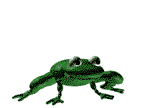 There once
was a young woman who was very vain. Her father was the village chief and her family was very respected. Many young
men wanted to marry her, but she thought that she was too good for all of them. One day, she and her sister were
walking beside the big lake in their village. That lake had many frogs. Several of them were sitting on a mud bank,
in the middle of the lake, and she started making fun of them. There once
was a young woman who was very vain. Her father was the village chief and her family was very respected. Many young
men wanted to marry her, but she thought that she was too good for all of them. One day, she and her sister were
walking beside the big lake in their village. That lake had many frogs. Several of them were sitting on a mud bank,
in the middle of the lake, and she started making fun of them."How ugly those frogs are," she said. Then, she stooped over and picked up one which was sitting on the shore and looking at her. "You are so ugly," she told that frog. "Even another frog wouldn't marry you!!" With that, she threw the frog back into the lake. That very night, when the young woman stepped outside of her lodge to walk, while everyone else was sleeping, she was surprised to see a young man standing there. His clothing was decorated with beautiful green beads and he was very handsome. "I have come to marry you," the young man told her. "Come with me to my father's house." The young woman agreed. She had never seen such a handsome young man and wanted to be his wife. "We must climb this hill to get to my father's house," the young man said and he pointed to the lake. They started to walk down to the water, but to the young woman, it felt as though they were climbing a hill. When they got to the water, they didn't stop...they went under. The next morning, the young woman's family noticed that she was missing. They looked everywhere for her and when they discovered the footprints leading to the water, they decided that she must have drowned. They beat the drums and held a death feast. People, in the village, cut their hair and blacked their faces and mourned the loss of the young woman. 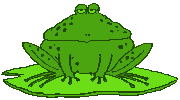 One day, however, a man was walking down by the lake. When he looked at the middle, he saw alot
of frogs sitting on the mud bank. And there, in the middle of all those frogs sat the chief's lost daughter!!!
He began to wade out towards the frogs, but they leaped into the water, and took the young woman with them. One day, however, a man was walking down by the lake. When he looked at the middle, he saw alot
of frogs sitting on the mud bank. And there, in the middle of all those frogs sat the chief's lost daughter!!!
He began to wade out towards the frogs, but they leaped into the water, and took the young woman with them.The man went very quickly to the chief's home. "I have seen your daughter!" he said. "She has been taken by the frogs. I tried to get to her, but the Frog People took her with them under the water." The young woman's mother and father went down to the lake. There, they saw their daughter sitting on the mud bank surrounded by the Frog People. Just like before, when the chief tried to reach her, the frogs leaped in and carried her under the lake with them. Then, the chief's other daughter spoke. "My sister insulted the Frog People," she said. That is why they have taken her. The chief knew then what he must do. He made offerings to the Frog People, asking them to forgive his daughter. They placed dishes of food on the surface of the water. The dishes floated out, to the middle of the lake, and then sank. But, the frogs wouldn't give the young woman up. Then, the chief placed robes, of fine skins, on the bank. The young woman and the Frog People came to the bank and took the robes. But, when the chief came close, the Frog People drew her back into the lake. The Frog People just would not give up. At last, the chief had a plan. he gathered together all of the people in the village. "We will dig a trench," he said. "We'll drain all of the water out of the lake, and rescue my daughter." The people dug for a long time and the water began to drain away. 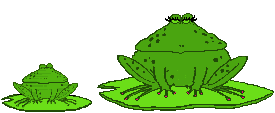 The Frog People tried to fill the trench with mud, but they couldn't stop the water from flowing
out of the lake. The Frog People tried to drive the people away, but the people only picked up the frogs and dropped
them back into the water. They were very careful not to hurt any of the forgs, but they didn't stop digging the
trench. The water kept flowing out and the homes of the Frog People were being destroyed. The Frog People tried to fill the trench with mud, but they couldn't stop the water from flowing
out of the lake. The Frog People tried to drive the people away, but the people only picked up the frogs and dropped
them back into the water. They were very careful not to hurt any of the forgs, but they didn't stop digging the
trench. The water kept flowing out and the homes of the Frog People were being destroyed.At last, the chief of the Frog People made a decision. After all, it was his son who married the young woman. "We aren't strong enough to fight these humans," he said. "We must give my new daughter-in-law back to her people." So, they brought the young woman to the trench. Her father and mother saw her and pulled her out. She was covered with mud and smelled like a frog! One frog leaped out of the water after her. It was the frog that had been her husband. But, the people carefully picked him up and put him back into the lake. The chief took the young woman home. For a long time, she could only speak like a frog does. "Huh, Huh, Huh!!" But, finally, she began to speak like a human again. "The Frog People know our language," she told the people. "We must not talk badly about them." 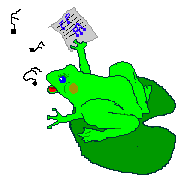 So from that day on, the people showed great respect to the Frog People. They learned the songs that the woman had brought from the Frog People and they used the frog as an emblem They learned a great lesson. They never forgot what happened to the young woman who was too proud. To this day, when the people of the village hear the frogs singing, they say that the Frog People are telling their children this story, too. |
|
Listen to the Bullfrog |
|
Make an Origami Jumping Frog |
|
Print and Color Your Own Frog |

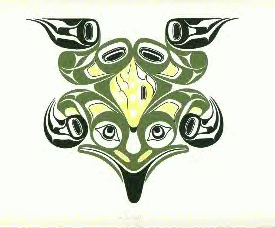
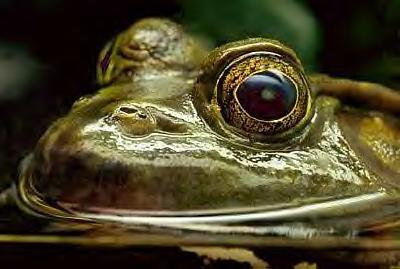
 The bullfrog has no natural predators, thanks in part to the toxic secretions its skin produces
when touched, and animals that manage to capture the bullfrog often release them due to the unpleasant taste. Coupled
with the strength of its long legs, the bullfrog very often never concerns himself with danger.
The bullfrog has no natural predators, thanks in part to the toxic secretions its skin produces
when touched, and animals that manage to capture the bullfrog often release them due to the unpleasant taste. Coupled
with the strength of its long legs, the bullfrog very often never concerns himself with danger. 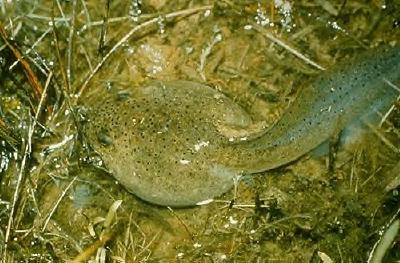 TADPOLES
TADPOLES